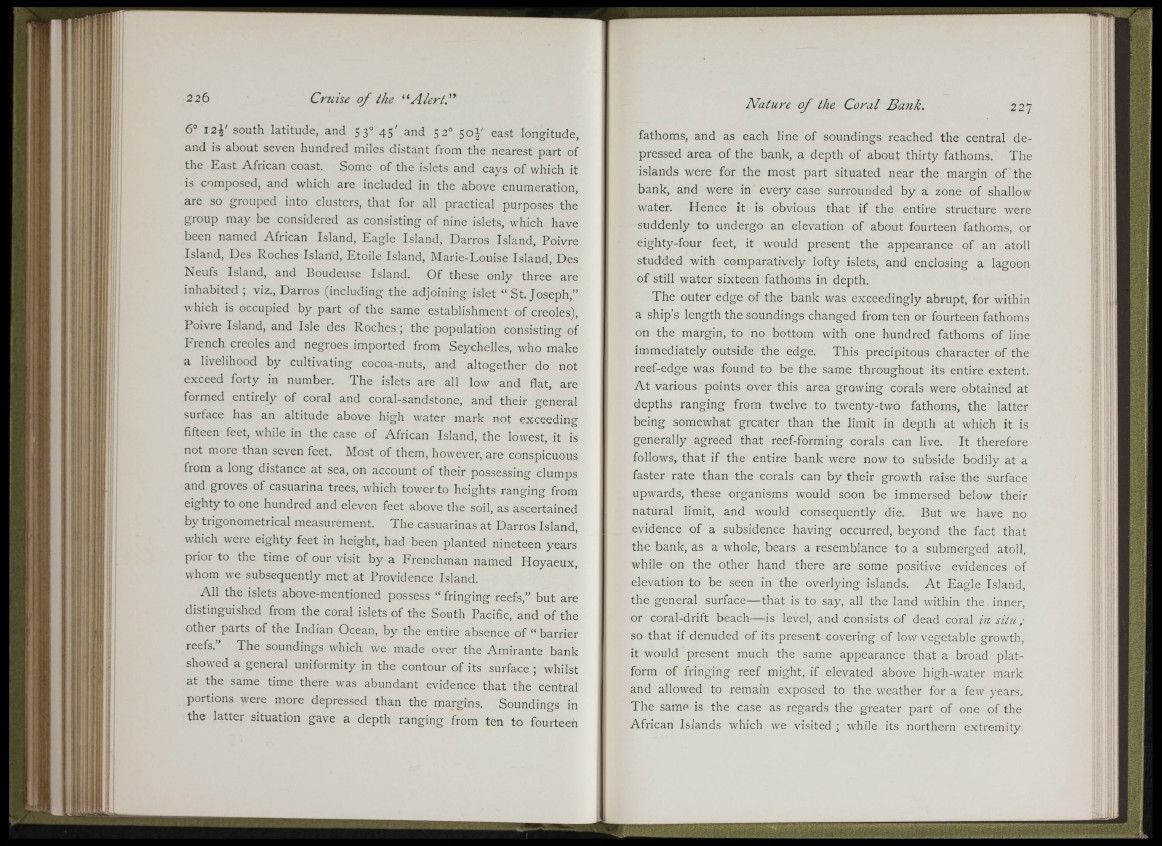
il
< iri
1 : *' ' ú'
6° I2 i ' south latitude, and 53° 45' and 52° 501' east longitude,
and is about seven hundred miles distant from the nearest part of
the East African coast. Some of the islets and cays of which it
is composed, and which are included in the above enumeration,
are so grouped into clusters, that for all practical purposes the
group may be considered as consisting of nine islets, which have
been named African Island, Eagle Island, Darros Island, Poivre
Island, Des Roches Island, Etoile Island, Marie-Louise Island, Des
Neufs Island, and Boudeuse Island. Of these only three are
inhabited ; viz., Darros (including the adjoining islet “ St. Joseph,”
which is occupied by part of the same establishment of creoles),
Poivie Island, and Isle des Roches ; the population consisting of
French creoles and negroes imported from Seychelles, who make
a livelihood by cultivating cocoa-nuts, and altogether do not
exceed forty in number. The islets are all low and flat, are
formed entirely of coral and coral-sandstone, and their general
surface has an altitude above high Avater mark not exceeding
fifteen feet, Avhile in the case of African Island, the lowest, it is
not more than seven feet. Most of them, however, are conspicuous
from a long distance at sea, on account of their possessing clumps
and groves of casuarina trees, which tower to heights ranging from
eighty to one hundred and eleven feet above the soil, as ascertained
by trigonometrical measurement. The casuarinas at Darros Island,
which Avere eighty feet in height, had been planted nineteen years’
prior to the time of our visit by a Frenchman named Hoyaeux,
whom Ave subsequently met at Providence Island.
All the islets above-mentioned possess “ fringing reefs,” but are
distinguished from the coral islets of the South Pacific, a’nd of the
other parts of the Indian Ocean, by the entire absence of “ barrier
reefs.” The soundings which we made over the Amirante bank
shoAved a general uniformity in the contour of its surface ; whilst
at the same time there was abundant evidence that the central
portions were more depressed than the margins. Soundings in
the latter situation gave a depth ranging from ten to fourteen
Nature o f the Coral Bank.
fathoms, and as each line of soundings reached the central depressed
area of the bank, a depth of about thirty fathoms. The
islands were for the most part situated near the margin of the
bank, and were in every case surrounded by a zone of shallow
water. Hence it is obvious that if the entire structure were
suddenly to undergo an elevation of about fourteen fathoms, or
eighty-four feet, it would present the appearance of an atoll
studded with comparatively lofty islets, and enclosing a lagoon
of still water sixteen fathoms in depth.
T he outer edge of the bank was exceedingly abrupt, for Avithin
a ship’s length the soundings changed from ten or fourteen fathoms
on the margin, to no bottom with one hundred fathoms of line
immediately outside the edge. This precipitous character of the
reef-edge was found to be the same throughout its entire extent.
A t various points over this area growing corals Avere obtained at
depths ranging from tAvelve to twenty-two fathoms, the latter
being somewhat greater than the limit in depth at which it is
generally agreed that reef-forming corals can live. It therefore
follows, that if the entire bank Avere now to subside bodily at a
faster rate than the corals can by their growth raise the surface
upAvards, these organisms would soon be immersed below their
natural limit, and would consequently die. But we have no
evidence of a subsidence having occurred, beyond the fact that
the bank, as a whole, bears a resemblance to a submerged atoll,
while on the other hand there are some positive evidences of
elevation to be seen in the overlying islands. A t Eagle Island,
the general surface— that is to say, all the land Avithin the inner,
or coral-drift beach— is level, and consists of dead coral in s itu;
so that if denuded of its present covering of low vegetable growth,
it would present much the same appearance that a broad platform
of fringing reef might, if elevated above high-water mark
and alloAved to remain exposed to the weather for a few years.
The same is the case as regards the greater part of one of the
African Islands which we visited ; while its northern extremity